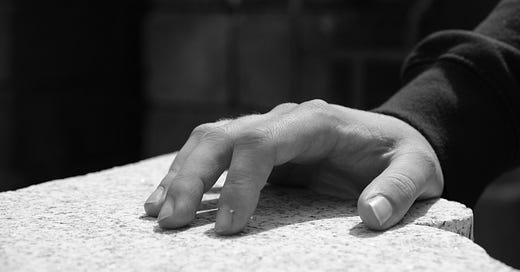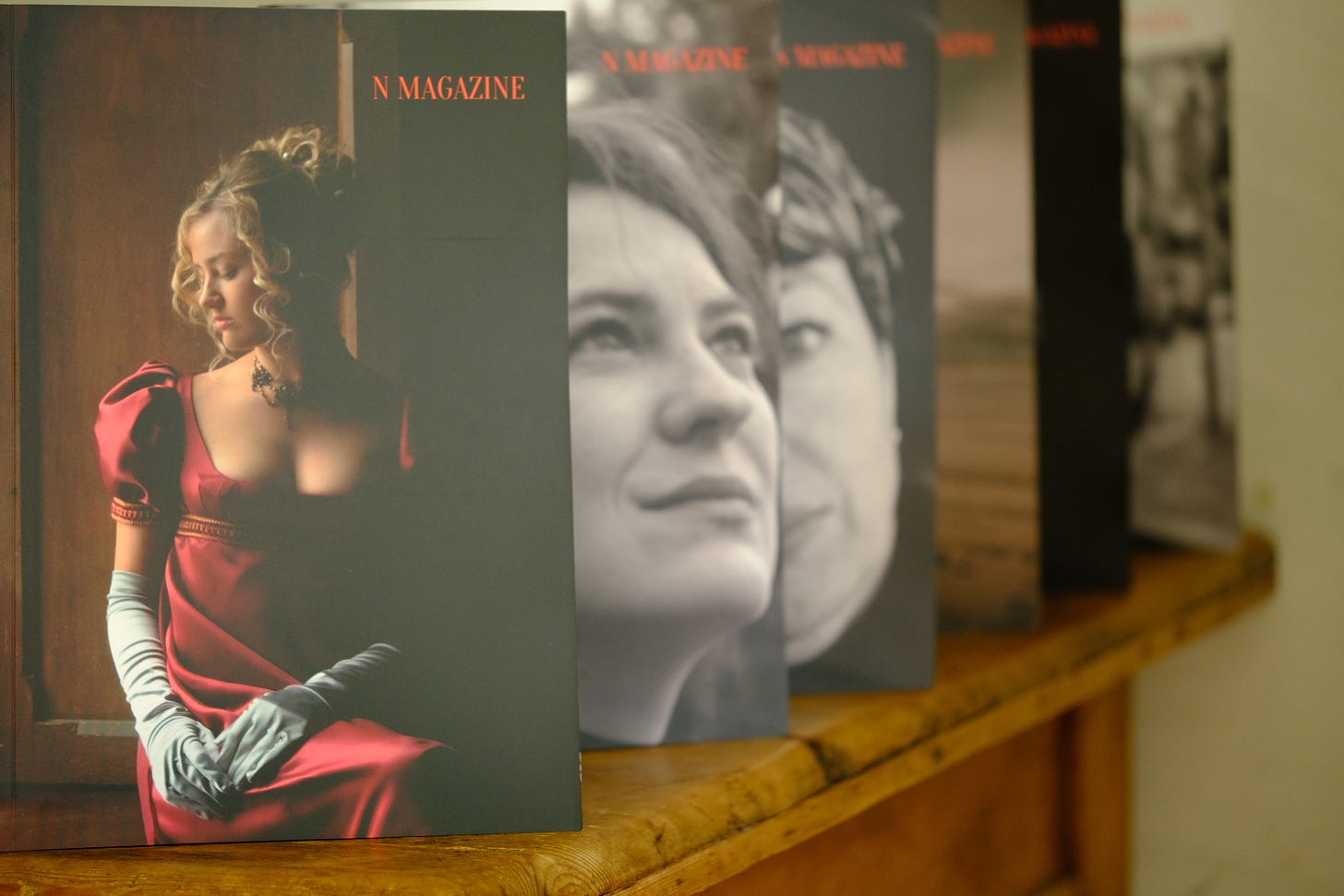Thank you for joining the mailing list of Ireland’s new art magazine.
Every Wednesday and Saturday for the rest of 2023, you’ll meet a new and extraordinary Irish artist in your inbox.
This article was first published in N Magazine No.7, which is available at the National Gallery, various lifestyle and design stores around the planet and of course on our website.
Enjoy!
Aoife x
Killian O’Flaherty
I thought I knew Wicklow as a child, all oak trees and big gates, but there are many sides to this county.
There is the grey sea at the edge, the loneliest of mountains in the centre and in the South West, there is a little granite village called Ballyknockan.
Surrounded by lakes both natural and unnatural, this hillside village is a winding series of paths and lanes that snake through cut stone cottages; you see, this was the home of Dublin’s finest stonemasons.
Ballyknockan sits right on the edge of a vein of granite that runs from Co. Carlow, through Wicklow, right into Dublin Bay. Whilst Dublin granite is as hard as iron, granite from this village is tough but flexible enough for details.
Once Georgian Dublin got wind of this, the race was on; hundreds of men were employed from this village alone to quarry, carve and transport the stone destined for Dublin’s most recognisable landmark buildings.
Catholic Emancipation in 1823 marked the beginning of this building boom; the churches of St. Andrew, St. Paul and St. Francis Xavier were all built with Ballyknockan granite.
Add in Heuston Station, the Central Bank and Fusiliers’ Arch and you’ll quickly realise it's hard to walk through Dublin without seeing Ballyknockan stone.
This year marks the official bicentennial of Ballyknockan’s stone carving tradition, so we took a trip up to the granite village to meet the stone mason, letter cutter and sculptor Killian O’Flaherty.
Killian runs a thriving stone cutting and masonry business that specialises in historic buildings. No better man for it; a self defined architecture nerd and eighth generation stonemason, Killian has worked on Dublin’s major restoration projects, like the Dail and the Gate of Justice at Dublin Castle.
However O’Flaherty Stone does not just offer conservation services; they also offer sculptural and monumental work whilst new building projects form a small but expanding part of the business.
Stonemasons take education quite seriously; Killian believes that the more people that do what he does, the better.
Killian works with an apprentice, his sister Petra O’Flaherty, who has garnered considerable media coverage as the first Irish registered female stonemason apprentice for over 30 years.
When teaching a profession that sits neatly between a trade and an art form, Killian believes it is important to offer apprentices the freedom to express themselves creatively.
Stonemasonry is a specialised field with only a handful of apprentices each year, but those few apprentices benefit from a thousand year system of guilds and international training.
Though Killian’s scheduled Tour de France with the French guild of masons Les Compagnons was cancelled in 2020, he has worked with the finest European and American craftsmen; following in his footsteps, Petra will be setting off to Rhode Island shortly.
Compared to other European countries, Ireland is a little late to the restoration party. We have a curious relationship to heritage buildings, to say the least.
But in Killian’s opinion there has never been a better time be working with stone, whether it's sculpture, masonry or architectural conservation.
‘We've always been a country of makers. I think there's a big revival in stonemasonry now.’
People are, in a sense, rediscovering stone, a sustainable material if ever there was one.
That is, if it’s local.
Just like Ireland imports clothing, food and everything else at an alarming rate, apparently we also import stone from China. Now it’s difficult to explain why a nation perched on top of a rock in the middle of the Atlantic imports stone from the other side of the globe; Killian says Chinese stone unsurprisingly doesn’t weather very well in the Irish climate.
There is only Irish stone to be found here in Ballyknockan.
If you’re looking to build a house, Killian is the man to talk to; if it’s a home, talk to his wife, Tehseen, midwife and founder of Wild Mountain Mothering, a powerful collective of doulas and experts. She cultivates a beautiful energy in their home which is all yellow doors and raspberry bushes, overlooking the reservoir of Poulaphouca. Neighbours told the young couple recently that the first couple who lived in this stone cottage were a midwife and stonemason; life comes full circle.
Tucked behind the house is Killian’s personal project, a restoration of an 1800s stable building into a modern day stone cutting workshop.
In the peak of Dublin’s granite craze, 200 draft horses worked alongside hundreds of men to transport Ballyknockan stone the 25 mile journey to the city centre; this building, which had fallen into disrepair in the intervening years, served as a foundry.
A beautiful combination of heritage masonry and Killian’s finest stone cutting, the yet unfinished project has already won him international recognition.
Last year, Killian was nominated for craftsperson of the year in the under 30s category in the Society for Protection of Ancient Buildings Heritage Awards; the nomination is an indication of the striking quality and artistry of Killian’s work.
As the first ever Irish Nominee to be put forward for nomination in a competition of applicants from England, Ireland, Scotland, Wales and Northern Ireland, Killian laid down his tools, popped over to Soho and made it to the top four.
Killian envisions this building as a showcase of Ireland’s ancient tradition of stone carving, with each detail carefully and lovingly considered.
The building will have an impressive number of architectural features when completed in the next year or so; think wall width window sills, specially carved columns and an arch that almost defies description.
With keystones weighing between 600-700kg each, relief lettering that dances in the sunlight and a carved hand and chisel that took weeks to complete, Killian jokes the building tour will involve a trip up the ladder to view the arch’s details.
Killian uses power tools like angle grinders and pneumatic tools to remove the bulk of stone; all carving is then completed by hand with a hammer and chisel. Apparently laser cutter sculpture is still somewhat of a myth. Perhaps the machinery will exist in 50-60 years, but not today.
Here in the unroofed barn, giant blocks of deep blue granite wait their turn to be carved; under a tarp is hidden dozens of completed pieces destined for the under eaves section of the front wall.
Killian described the process of carving 3D cabled twists on a curved stone as a simultaneous nightmare and privilege. It’s a mind bending design problem which was solved using only a compass and a pen to draw guide lines on the rough block before carving.
In terms of the final aesthetic of the project, Killian wants the finished workshop to look like it was always there. He resisted external advice to add glass skylights and such frivolities; he instead followed his own intuition to use historical building techniques which, unlike modern construction, have an excellent track record.
‘Everything that I do was mastered and perfected hundreds, if not thousands, of years ago. We know it lasts.’
As eighth generation stonemasons, these folks live and breathe stone. Their work grants them an unparalleled knowledge of their materials; just by glancing at the colour of a stone, they can tell how deeply it was quarried. Stones around these parts yield healthy babies and protection from famine; the long fingers of the Great Hunger never reached this village thanks to Dublin’s simultaneous building boom.
Stonemasons, as a group, are short on illusion and long on humility; the very real chance of destroying weeks of work with one misstep will do that for a man.
Killian’s personal aims are simple and timeless; raise a family, build a business.
He’s well on his way to both of those goals.
We would like to congratulate Killian and Tehseen on the recent arrival of Thomas O’Flaherty, 9 stones, 9th generation of stonemason.
If you would like to learn more, please visit Killian’s excellent website
www.oflahertystone.com and follow @killianoflaherty on Instagram.
Ballyknockan is well worth a visit; Killian and Petra will be hosting a walking tour through the village on August 20th as part of Heritage Week 2023.
https://www.heritageweek.ie/event-listings/200-years-of-ballyknockan-a-living-history
Photography & article by Aoife Long.
This article was first published in N Magazine No.7 which is available in print here.
If you would like to treat yourself or a loved one to Ireland’s new art magazine every month, we would invite you to consider a 3, 6 or 12 month print magazine subscription.
For readers in Ireland, print subscriptions begin at just €45 for 3 months and €66 for 3 months for US readers.








